Iain Oughtred, the Australian-born boat builder and designer whose boats frequently appear in Small Boats, passed away on February 21, at the age of 84, in a hospital near his home on Scotland’s Isle of Skye. During his career as a designer, which began in 1967, Iain designed well over 100 boats. They ranged in length from his 6′ 8″ Feather, a pram dinghy, to the 41′ 8″ Gipsy Queen, a clipper-bowed ketch. Between Small Boats and the Small Boats annuals, we’ve reviewed 15 of Iain’s boats. I corresponded with him in connection to the reviews but never met him and most of my impressions of him came through his drawings, his book Clinker Plywood Boatbuilding Manual, and the Caledonia Yawl I built 20 years ago to his plans. Iain, here at his drafting table while living in Findhorn, is wearing several layers to keep warm. Nic Compton, who took this photo, noted that Iain was a frugal man and preferred bundling up to the more costly option of using central heating.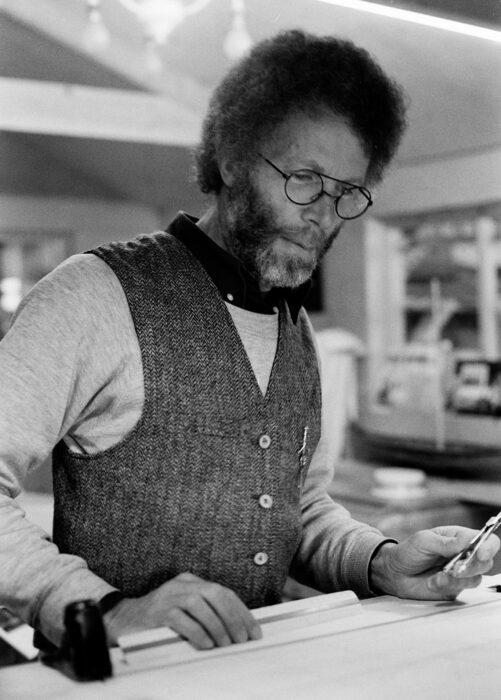 Nic Compton
Nic Compton
Join The Conversation
We welcome your comments about this article. If you’d like to include a photo or a video with your comment, please email the file or link.

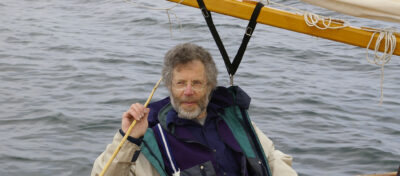
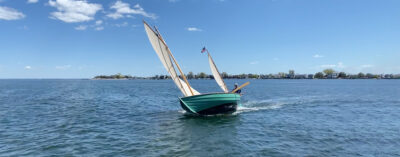
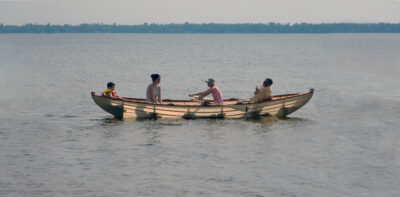

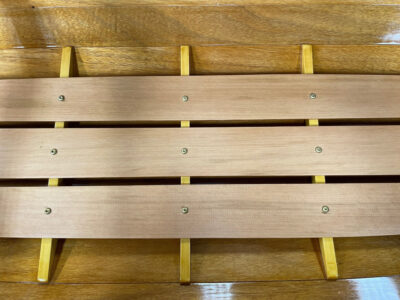
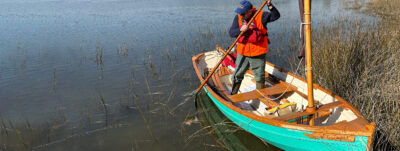
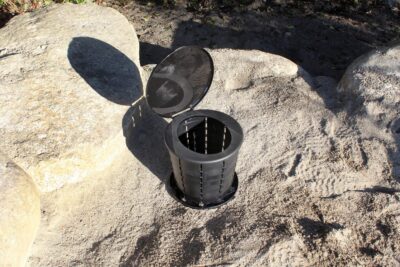
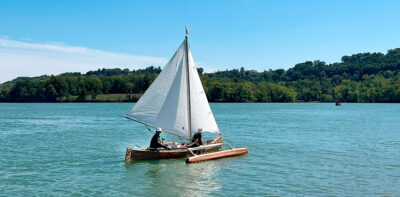

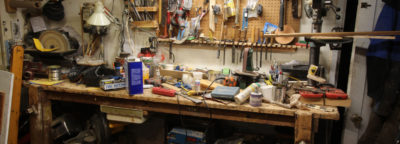
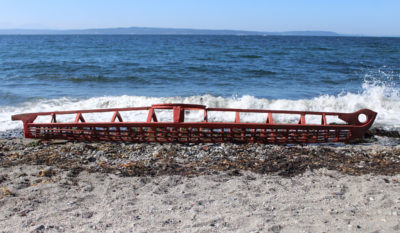
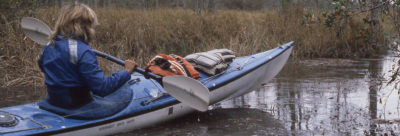
I taught myself (with a little help from a friend) to sail on an undecked MacGregor Canoe. I loved the clinker plywood approach, the plans that never left me “hanging” for an answer and it survives today after 30-odd years of service. I enjoyed it so much and needed a larger boat for Long Island (NY) waters so I completed an Oughtred Whilly Boat, also lug rigged. This one I sailed without a boom, lug-rigged and when necessary could row it back to shore. Somehow Iain Oughtred’s designs seemed to fit me and his passing saddens me deeply.
Ed Frankel
Baldwin, NY
My son, Finn, needed a tender, and I needed to scratch my itch to find what beauty is at its heart. We built the Auk, aided by Iain’s helpful book and exceptional drawings. It was a happy experience, the first boat for either of us. It seemed to come alive when we put it into Puget Sound.
I join you in your sadness.
I sent this poem to Iain with my thanks.
An Oughtred Boat
the beauty of these curves—
bursting, brooding, enigmatic,
promising, smiling even
in the waves, the waves
bearing this insouciance lightly
as though holding a baby
or an egg or hope itself—
made by hand,
to carry your soul
across the bay
Very sad to hear of Iain’s passing. He has left a major mark in the field of small-boat design.
I always liked the look of his boats, particularly the Caledonia Yawl. That lead in 2012 to a couple of weeks at the WoodenBoat School building one (Swifty) under the direction of the ever-patient Geoff Kerr. In 2013 I wanted plans. In the Fall of that year I was in Skye for a walking holiday, so I thought I would seek Iain out and get them from the source. I left my wife with the car for 10 minutes to buy the plans. Over an hour later I returned. She was very forgiving! Iain was a delight to talk to, and we covered a lot of ground from boats to wooden aeroplanes.
The boat never got built but I still cherish the plans, even more so. We have lost a great character.
I’ve never built or sailed one of designs but have spent hours looking at them & day dreaming. Sorry to hear about his death. I hope all of his designs still stay available.
I started building an Acorn Tender but got distracted by another project, thinking I would some day get back to it. Seeing I still have the transom, stem and hog, maybe this is a good time to pick it up again.
Reading the “Over the Bar” column in WoodenBoat, it seems that those who design, build or are associated with wooden boats have greater longevity.
Chris, thanks for these insights on Iain and the Caledonia. I knew it had ample sail area but had not heard the reason for it before. And yes when I first saw it it was its looks that first drew me toward the design. When I first launched mine in 2022, I rented a slip in a marina for a week. Three different boat owners in the marina asked me if I did the restoration. It truly looks like it came from a time gone by. I love that.
Ten years ago I was the lead wood-arts teacher at a local school and a group of my senior students built a St.Ayles Skiff for their senior project. Built from a kit, it was a beautiful design and much admired.
Somewhat regretfully, at the end of the year, the school was intimidated by the possible liability of having students row or race a “home-built” boat so they offered it to me.
Not wanting the boat to go unused, I reached out to Iain by mail (he was not an email guy) and asked his advice about the possibility of converting it to sail and how much plans might cost to do just that. A few weeks later I received a letter in impeccable script and an auxiliary set of St. Ayles plans to convert our beloved boat to sail. He charged me nothing and thanked me for building one of his boats with kids. That is a small testament to the man that Iain was and may he rest in peace.
Thank you Jim for this reminder of the wonderful nature and talent of this dear man. From my mid teenage he was first a hero as an excellent Gwen-12 dinghy sailor, my own first boat, who went on be Australian Champion in the class. Always a talented builder and draughtsman he re-drew the original plans to facilitate easier construction and improved technique. His later career as the very talented yacht designer was little surprise. Along the way I purchased plans for Gannet, which remains un-built and will remain that way at age 75. Beautiful, practical art. It’s with sadness and warmth that I remember him.
Ian stands up there with my other great, Maurice Griffiths.
Aged out of our fine Wee Seal mk2 Kelpie (WB Building a Wee Seal slowly) now trying to finish my project Caledonia Yawl found as a bare abandoned hull. The builder made some planking errors so gave up and left it in a drive shed then sold the farm. Should be on the water this year for sure, plank errors and all.
When I began in 2018 to work on a model of my first plywood boat, a design that I developed by myself, I heard the first time of Iain Oughtred’s boat plans. I whished to have a mentor designing a boat that I could not try before completely finishing it. I tried to contact him but got no reply. I bought the manual for building plywood boats second hand in the UK and found it spoke to what I was thinking. For what were only ideas before, I found solutions and only by looking at the drawings and fotos I felt like being enabled, building step by step.
In 2022 my daughter and I had been at a road trip around Scotland and my plan was to visit Iain if he would like to. Prior to our trip, I sent a postcard and while we were around, I just called if we could drop in for visit. Iain replied “Yes, but when would you be here? I have to clean up a little.” We bought chocolate cake and drove to his cottage. After we arrived Iain changed clothes and looked like at the first picture taken by Nic Compton. We settled at his drawing table in his kitchen and were immediately into deep discussion of plans and fotos I had brought. Finally he rolled out one of his original plans of the Caledonia Yawl at the table in his tiny kitchen, which he wasn’t able to clean up before our visit. I was struck by the clearness and order of his hand-drawn, perfect plan of this boat. During the three hours of intense discussion, Iain got more and more open, coming up with details and stories, telling us about friends that planned projects and got too old, and others that were still on going with him helping out, answering questions and making drawings. When my daughter and I left Iain’s little cottage we remembered the chocolate cake: We had been to busy on boats to eat it.
I finished the boat in 2019, very happy to successfully translate an otherwise lost traditional type of boat into plywood. Even if I couldn’t ask Iain for Tip’s and Tricks on how to do that, I now know that I could find most answers in the book from him. In 2022 I ordered two plans, that were directly shipped by him and hope all the original plans will be safely stored.
You can add my BONNIE LASS to the number of Caledonia Yawls in the North Seattle area. I keep her trailered at my home in Lake Stevens, but most often launch from Everett. I bought her in 2022 from a Camano Island man who bought her from Seattle’s CWB in 2014. She is an old boat, and only through a full year of research, starting with an email from Iain himself, was I able to track down her original owner, Peter Mumford. It turns out BONNIE LASS was originally named ERIKA, commissioned from Iain by Peter in 1988, and built before Ian had even completed his drawings for the interior furniture of what would become the Caledonia Yawl. Peter brought ERIKA with him when he moved from New England to Seattle in the 1990s, and eventually donated her to CWB, where she remained in their livery for decades. Reading your story, I wonder if she’s isn’t the very boat you rented with your kids back in 2004. It truly is a remarkable design.
Hi Drew,
Yes, that was indeed the Caledonia my kids and tried out at the Center for Wooden Boats. I’m glad to learn that she’s still around and in good hands!
Chris
I owned his books, plans, and a Acorn to row. I always admired his old-school approach to drafting and design. Corresponded a couple times on plan details, he was always ready to respond with the required information. A master of his craft.
My intro to boatbuilding was a CLC dory, but the CNC perfection left me eager to try one from plans. So I ordered Ian’s book and WEE ROB. Now I can sight down the strakes of my canoe and see imperfections. I improved the lines on my next build, Ian’s AUK, which I still have the fitting out and finishing to do before my next build: his TAMMIE NORRIE. I love his boats–especially the multi-strake–and will keep on conversing with Ian through his book and his plans.
I would have loved meeting Iain. I built my own Caledonia yawl after looking at many, many boat designs and immediately picked it as the one that would work the best for me. I am very thankful for his ingenuity and knowledge.